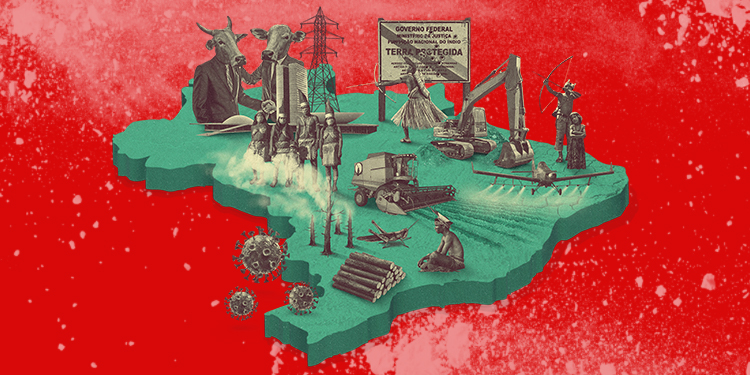CENTRAL NEWS – The Pan-Amazon, an area of 8.47 million km² which covers across Brazil, Bolivia, Peru, Ecuador, Colombia, Venezuela, Suriname, Guyana and French Guiana, lost 724 thousand km² of forest and vegetation coverage between 1985 and 2018, according to an analysis made by MapBiomas Amazonia. The area lost is equivalent to the sum of the states of the entire territory of Chile. Brazil concentrates most of the biome (61.8%) and was also the country that lost most forest cover in the period, both in absolute and proportional terms: it is 624,000 km² less. Next comes Bolivia, with 36,000 km²; Peru, with 16,000 km²; and Colombia, with 14,000 km².
In 1985 there were 415,000 km² of agricultural and livestock activities throughout the Pan-Amazon. In 2018, it increased to 1.12 million km² – almost three times more. Most of the growth came from Brazil. In 1985, there were 319 thousand km² of land for agriculture and cattle raising. In 2018, it was 960 thousand km².
This is an direct consequence of the capitalist mentality of exploitation in the region. The Amazon forest its being destroyed in the name of “economical progress of the agriculture of the country.”
The consequences of the election of the fascist Bolsonaro
The destruction of forest areas in the Amazon continues to show alarming rates. In the period from August 2018 to July 2021, deforestation in the biome increased by 56.6% compared to the same period in previous years. The survey was conducted by the Amazon Environmental Research Institute (Ipam).
For Ipam, the advance of deforestation in the Amazon became more evident from the management of President Jair Bolsonaro, elected in 2018, through the weakening of enforcement agencies, lack of punishment for environmental crimes and significant reduction of immediate actions to combat and control illegal activities in the region. According to the survey, more than half (51%) of the deforestation in the last three years occurred on public lands. 83% was in areas of federal domain. Part of the devastation is concentrated around two federal highways that cross northern Mato Grosso and western Pará.
Fines for illegal deforestation in the Amazon have been virtually suspended since October 2019 due to a decree of the Bolsonaro government, according to the nongovernmental organization Human Rights Watch.
Preferred targets
Half of the deforestation, according to IPAM, occurred on public lands, most of them – 83% – belonging to the Union. The greatest loss of vegetation occurred in territories classified as “Undesignated Public Forests”, where there was an increase of 85%. These areas are the most vulnerable, since they have little or no state presence related to monitoring or inspection.
When calculating the ratio between the deforested area and the size of the territory, IPAM concluded that the Indigenous Lands were most affected, with an increase of 153% between the triennial periods analyzed by the research. As for the Conservation Units, where human action is regulated by the State, there was a proportional growth of 63.7%.
Free Land Camp – Acampamento Terra Livre
The 305 indigenous peoples that currently exist in Brazil want to be protagonists of their life plans, of autonomy in their territories and also to be guaranteed the right to participate in the formulation, monitoring and evaluation of the public policies that concern them. These demands are in the final document approved by the participants of the 2022 edition of the Acampamento Terra Livre (ATL).
The largest indigenous mobilization in the country, this year the event had the largest edition in its 18-year history. There were about eight thousand indigenous people from 200 peoples, who gathered in Brasilia between April 4 and 14. The program involved assemblies, discussions and protests near the National Congress.

The final document was released by the Articulation of the Indigenous Peoples of Brazil (Apib) and brings proposals to “rebuild” the country. In the text, the indigenous movement describes that, as in the times of the colonial invasion, there is currently “a declared plan of death, ethnocide, ecocide and genocide never seen in the last 34 years of democracy” in Brazil.
“Bolsonaro, since his electoral campaign and already on the first day of his mandate, has uttered racist and hateful speeches against indigenous peoples, electing us as his preferred enemies,” the text points out.
The attacks led or encouraged by the federal government include, in the view of the ATL participants, the defense of the “integration” of indigenous peoples “to the so-called civilized society” and a “propagandized national culture”, aiming to dissolve diverse socio-cultural identities. “The current president is also working to legalize the activities of criminal organizations that act in the territories: gold miners, lumber companies, cattle ranchers, militiamen, and land grabbers.
Attacks against indigenous community Yanomami
On the evening of April 25, the president of the Yanomami and Ye’kwana Indigenous Health District Council (Condisi-YY), Junior Hekurari Yanomami, released a video claiming that a 12-year-old girl had been raped and killed during an attack by miners.
In the same action, an aunt, according to him, tried to save the girl. In the confusion, a child, the aunt’s daughter, fell into the river and disappeared. Hekurari’s report, based on information he received over the radio from people in the region, was communicated by letter to the Federal Public Ministry, Funai and the Federal Police the next morning, the 26th.
The girl, according to Condisi-YY, lived in the Aracaçá community, a region of Waikás, where there is a strong presence of miners and where there has been the greatest advance of illegal exploitation, according to the report “Yanomami under attack”, by the Hutukara Associação Yanomami (HAY). In Aracaçá, there were about 30 indigenous people living there. Difficult to reach, it takes about 1h15 hours to fly from Boa Vista to Waikás. To reach the Aracaçá community, it takes another 30 minutes by helicopter or five hours by boat on the Uraricoera river.
On Friday (6), Júnior Hekurari informed that the indigenous people were located far from Aracaçá, some of them accompanied by miners.




